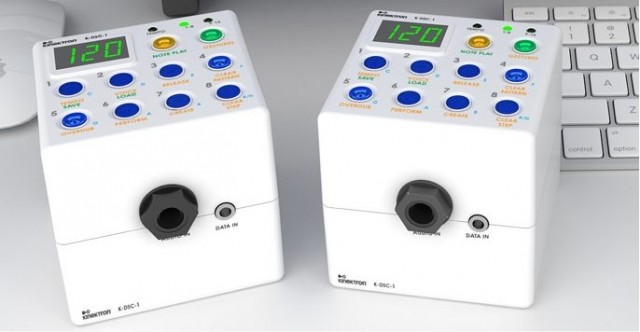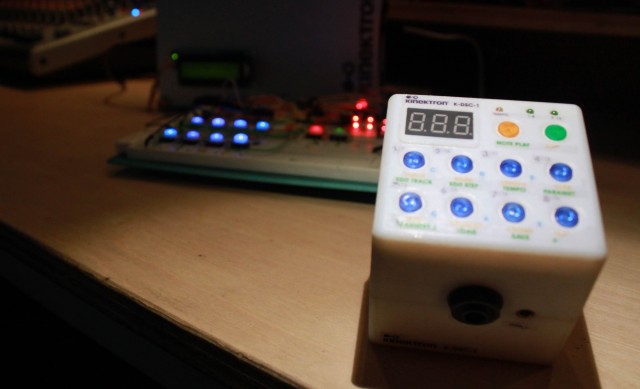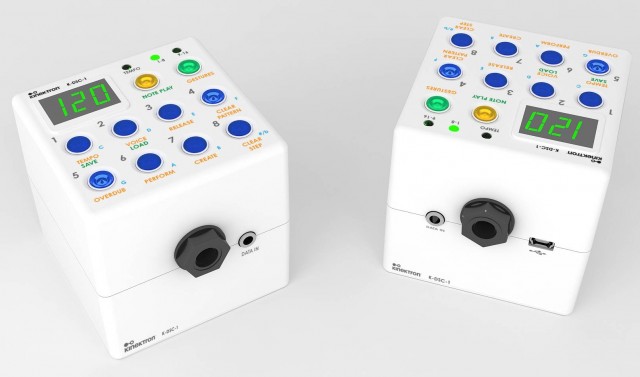How much music making can you pack into a space-age, sealed white box? Developers Kinektron proposed one solution last month. To examine their design direction so far, we turn to Create Digital Music’s summer intern in industrial design, Arvid Jense. Arvid is completing unique dual studies in Media Music (at the ArtEZ Conservatorium, Enschede) and BSc Industrial Design Engineering (at the University of Twente), both in the Netherlands. He’s working with us to research instrument design and musical interaction, and doing a set of studies and design experiments related to our own MeeBlip open source synthesizer. (More on Arvid and his work soon, as well as, of course, the results of those projects.)
As he tackles similar questions himself, here’s his frank look at what this whole Kinektron is about. -PK
A fresh company called Kinektron has presented this little white cube at summer NAMM 2012. The synth box, called the K-DSC-1, sports more than a few interesting features. To name just a few, that includes gestural editing, programmability over infrared, a hidden game, an open communication protocol, web-based pattern sharing, and Arduino compatibility. Whoa — that’s one ambitious little box. Where should I start on this? Let’s begin on the actual cube they’re presenting at NAMM.
The K-DSC-1 is described by Kinektron as a self-contained music production machine. It combines a 16-step sequencer with a General MIDI (GM) sound set, all editable using 10 buttons and a gestural editing system and put into a clean white case. The first cube should be available by early 2013, for US$200.
The gestural aspect is where this thing catches my attention. By “gestural,” they mean that you can edit parameters by physically moving the cube through space. The press release talks about tilting the cube after pressing a button, which might only be the start; check out this or this video of gestural control with an accelerometer, to see a couple of (unrelated) projects as illustrations of what’s possible. While it might be hard to imagine composing a song by shaking a white box through the air, it does have its advantages. I’m envisioning hands- and eyes-free operation of this device. Live performances of people almost juggling their devices seems a lot more entertaining to me than a performance of someone just bending over his laptop.
A curious side note to this: while they’re proposing a new type of interaction with the device, it runs on a General MIDI (GM) sound set. While this simple sound system is understandable in the ‘self-contained’ context, it doesn’t seem to match the ambitious, futuristic qualities of the instrument. Presumably the chip they’re using sounds quite a bit better than the Windows GS Wavetable Synth we all know — I guess this is what GM sounds like today — but I feel like it’s a strange choice when you’re introducing a revolutionary control system. They talk about a transistor distortion and digital delay to arrive at a ‘cool lo-fi’ sound. But I’d rather expect something ‘hi-fi’ from this almost medically-clean design.
This cube is not where Kinektron’s announcements stops: their description isn’t merely talking about the K-DSC-1, but describes an entire ‘Synth Cube System’. Next to the announced sequencer/GM cube, they’re planning on releasing a dedicated analog synthesizer, an analog percussion module, an effects processor, and a sound mixing cube with MIDI connectivity. I would love to see this network of little white cubes in action, yet in this context, the choice of making the K-DSC-1 self contained seems a bit unnecessary, if you will be using it as a sequencer for other devices anyway. (A self-contained music production device (K-DSC-1), which is part of the self-contained Kinektron Synth Cube System, which will be used within an existing MIDI setup… Inception, anyone?)
To connect the family of boxes, Kinektron is proposing their own ‘K-Konnect Open Protocol Interface’ to communicate. The K-Konnect Interfacing Protocol is running through 3,5mm cables to sync the devices. The word ‘open’ suggests they would like users and other vendors making to join in, but they’re describing something new, not an existing protocol. While we’ve all had our differences with MIDI, why isolate your product from standardization and not go for OSC – to say nothing of the time it takes to develop and test a reliable communications protocol. But if their protocol and the Arduino integration works as smoothly as they suggest (auto-negotiation, bi-directional, master-less operation), we might have ourselves a new standard for DIY synths and controllers!
To sum it up, Kinektron has a great product vision and comes with an announcement for a product that could be shaking the current synthesizer paradigm. But in this they seem to be heading for the common pitfall of trying to put all of the ideas in their first product, while keeping the price low. I would like this company to go full-on for the gesture control, to come out with a synth or sequencer without knobs and wires. (Why not go for wireless MIDI or even wireless audio while you’re doing something lo-fi anyways?) On the other hand, if they do pull it off — wow. I’m anxious to see a demo video from NAMM; until then I’ll have to do with dreams about a cute cubish production studio and the mysterious ‘hidden game’!
Some selected specs (from the maker):
- 32-Bit ARM7 Processor
- 18-Bit Digital-to-Analog Conversion
- Internal EEPROM Pattern Storage
- 8 Illuminated Step and 2 Function buttons
- 3-axis Accelerometer for parameter entry and sequence control
- USB Firmware Updates, USB Charging of NiMHNiCad AAA batteries
- 32 Voice Polyphony
- 4mb wavetable sound library, drum kit [General MIDI]
- 1/4″ Audio Input, 1/4″ Audio Output
- Two 3-Pin K-Konnect ‘open protocol’ interface** ports on 1/8″ stereo phono jacks
Kinektron-K-DSC-1-Paper-Synth-WebRelease.pdf
http://www.kinektron.com/products/kinektron-synth-cubes/


